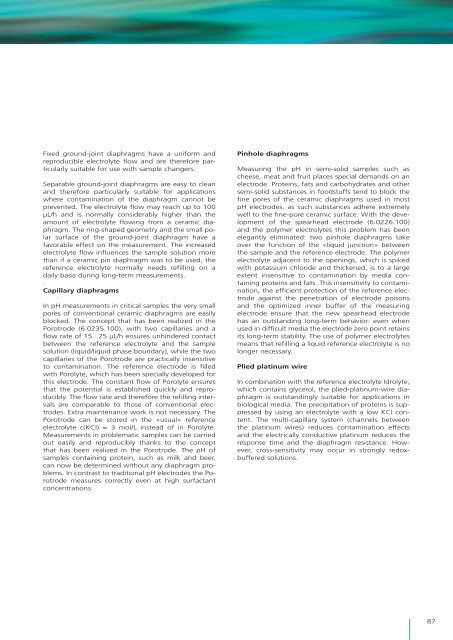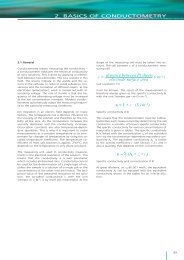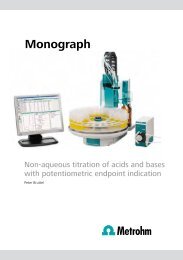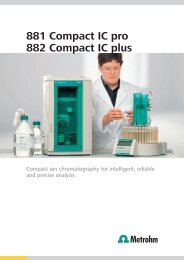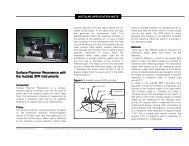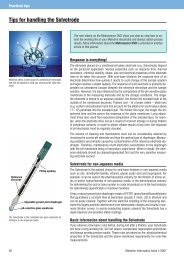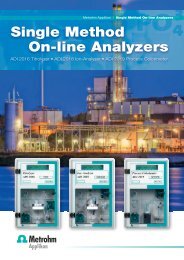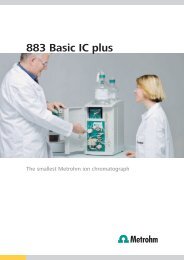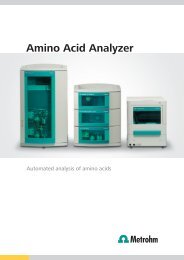What is the theoretical background of potentiometry? - Metrohm
What is the theoretical background of potentiometry? - Metrohm
What is the theoretical background of potentiometry? - Metrohm
Create successful ePaper yourself
Turn your PDF publications into a flip-book with our unique Google optimized e-Paper software.
Fixed ground-joint diaphragms have a uniform andreproducible electrolyte flow and are <strong>the</strong>refore particularlysuitable for use with sample changers.Separable ground-joint diaphragms are easy to cleanand <strong>the</strong>refore particularly suitable for applicationswhere contamination <strong>of</strong> <strong>the</strong> diaphragm cannot beprevented. The electrolyte flow may reach up to 100μL/h and <strong>is</strong> normally considerably higher than <strong>the</strong>amount <strong>of</strong> electrolyte flowing from a ceramic diaphragm.The ring-shaped geometry and <strong>the</strong> small polarsurface <strong>of</strong> <strong>the</strong> ground-joint diaphragm have afavorable effect on <strong>the</strong> measurement. The increasedelectrolyte flow influences <strong>the</strong> sample solution morethan if a ceramic pin diaphragm was to be used, <strong>the</strong>reference electrolyte normally needs refilling on adaily bas<strong>is</strong> during long-term measurements..Capillary diaphragmsIn pH measurements in critical samples <strong>the</strong> very smallpores <strong>of</strong> conventional ceramic diaphragms are easilyblocked. The concept that has been realized in <strong>the</strong>Porotrode (6.0235.100), with two capillaries and aflow rate <strong>of</strong> 15...25 μL/h ensures unhindered contactbetween <strong>the</strong> reference electrolyte and <strong>the</strong> samplesolution (liquid/liquid phase boundary), while <strong>the</strong> twocapillaries <strong>of</strong> <strong>the</strong> Porotrode are practically insensitiveto contamination. The reference electrode <strong>is</strong> filledwith Porolyte, which has been specially developed forth<strong>is</strong> electrode. The constant flow <strong>of</strong> Porolyte ensuresthat <strong>the</strong> potential <strong>is</strong> establ<strong>is</strong>hed quickly and reproducibly.The flow rate and <strong>the</strong>refore <strong>the</strong> refilling intervalsare comparable to those <strong>of</strong> conventional electrodes.Extra maintenance work <strong>is</strong> not necessary. ThePorotrode can be stored in <strong>the</strong> «usual» referenceelectrolyte c(KCl) = 3 mol/L instead <strong>of</strong> in Porolyte.Measurements in problematic samples can be carriedout easily and reproducibly thanks to <strong>the</strong> conceptthat has been realized in <strong>the</strong> Porotrode. The pH <strong>of</strong>samples containing protein, such as milk and beer,can now be determined without any diaphragm problems.In contrast to traditional pH electrodes <strong>the</strong> Porotrodemeasures correctly even at high surfactantconcentrations.Pinhole diaphragmsMeasuring <strong>the</strong> pH in semi-solid samples such ascheese, meat and fruit places special demands on anelectrode. Proteins, fats and carbohydrates and o<strong>the</strong>rsemi-solid substances in foodstuffs tend to block <strong>the</strong>fine pores <strong>of</strong> <strong>the</strong> ceramic diaphragms used in mostpH electrodes, as such substances adhere extremelywell to <strong>the</strong> fine-pore ceramic surface. With <strong>the</strong> development<strong>of</strong> <strong>the</strong> spearhead electrode (6.0226.100)and <strong>the</strong> polymer electrolytes th<strong>is</strong> problem has beenelegantly eliminated: two pinhole diaphragms takeover <strong>the</strong> function <strong>of</strong> <strong>the</strong> «liquid junction» between<strong>the</strong> sample and <strong>the</strong> reference electrode. The polymerelectrolyte adjacent to <strong>the</strong> openings, which <strong>is</strong> spikedwith potassium chloride and thickened, <strong>is</strong> to a largeextent insensitive to contamination by media containingproteins and fats. Th<strong>is</strong> insensitivity to contamination,<strong>the</strong> efficient protection <strong>of</strong> <strong>the</strong> reference electrodeagainst <strong>the</strong> penetration <strong>of</strong> electrode po<strong>is</strong>onsand <strong>the</strong> optimized inner buffer <strong>of</strong> <strong>the</strong> measuringelectrode ensure that <strong>the</strong> new spearhead electrodehas an outstanding long-term behavior: even whenused in difficult media <strong>the</strong> electrode zero point retainsits long-term stability. The use <strong>of</strong> polymer electrolytesmeans that refilling a liquid reference electrolyte <strong>is</strong> nolonger necessary.Plied platinum wireIn combination with <strong>the</strong> reference electrolyte Idrolyte,which contains glycerol, <strong>the</strong> plied-platinum-wire diaphragm<strong>is</strong> outstandingly suitable for applications inbiological media. The precipitation <strong>of</strong> proteins <strong>is</strong> suppressedby using an electrolyte with a low KCl content.The multi-capillary system (channels between<strong>the</strong> platinum wires) reduces contamination effectsand <strong>the</strong> electrically conductive platinum reduces <strong>the</strong>response time and <strong>the</strong> diaphragm res<strong>is</strong>tance. However,cross-sensitivity may occur in strongly redoxbufferedsolutions.87


